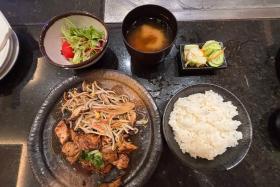Makansutra: Tap here for gourmet, heritage fare
Pick up your food from a locker at OUE Re:Store

The world's first automat or automatic food vending cafe was Quisisana, which opened in 1895 in Berlin, Germany.
It was a simple cafe that offered basic eats, and the world caught on.
Now, more than a century later, it is still viable.
And this week marks the opening of Singapore's latest iteration - a human-less digital automat. No cashiers, service staff and busboys.
The OUE Re:Store restaurant is a 7,000 sq ft space spread over two floors - one for casual public seating - that can serve up to 1,200 meals during peak lunch hours.
It is almost a fully automated system - there is no service at the front of house - with just four people to oversee the system at the back.
You search for what you want among the 20 dishes offered on the Downtown Gallery app (download it for free to start ordering), tell the system when you would like to pick it up, hit the "redeem" button when you arrive, and it directs you to one of the 120 digital vaults with your name on it.
We have certainly come a long way from the 1895 model.
-
#03-11, Downtown Gallery 6A, Shenton Way
10am to 7pm daily
Tel: 6513-7737
While I helped curate the project, I was more thrilled that I had the chance to rope in top regional chefs and a Michelin-starred exponent to help create the menu.
Each chef, including yours truly, came up with five items unique to their heritage and not easily found in Singapore or the vicinity.
Chef William Wongso, regarded as Indonesia's food ambassador, introduced the West Sumatra-style beef rendang padang (firm, not sweet, drier and intensely flavourful over rice) and nasi liwet (their spicy chicken rice).
Celebrity chef Sau Del Rosario from Pampanga in the Philippines came up with laing - dried taro leaves braised in coconut milk and stock with seafood and bagoong (Philippine shrimp paste).
This is one of the most comforting items offered in carinderias all around the Philippines.
His pork pochero, a tomato-based Spanish-style stew with greens, chickpeas and plantain, is rarely seen in Philippine menus in Singapore.
It is not spicy and comes tangy and sweet, with an umami aftertaste.
Chef Malcolm Lee, the first Peranakan Michelin star recipient, put what you cannot easily get into one box - buah keluak fried rice with roasted sambal chicken and greens.
He is not stingy with the black nut paste, and the results show.
He also introduced the rare Nonya-style lok lai yik (fermented red bean curd and braised chicken stew with greens and tau pok), but done with pork.
This earthy umami explosion in your mouth shows the Cantonese influence in local Peranakan culinary culture.
Besides working with partners to ensure a fuss-free digital ordering experience, seamless in-app payment system and smooth automated back-of-house operations, my task was to come up with five re-imagined local heritage and hawker fare.
And so the fried laksa loh see fun or rat tail noodle with curry yong tau foo was born.
Out of the well-liked imported mac and cheese, I created the salted egg yolk mac with prawns, crunchy celery chunks and sambal.
All packs weigh in at a substantial 400gm at least, and they are regenerated via a steaming method - "no microwave please" was my intent all along, and each dish was introduced with that in mind.

Prices range from $8 to $12 via in-app credit card or other payment systems.
At this rate, I won't be surprised if drone delivery or digital automats on wheels are next.
Get The New Paper on your phone with the free TNP app. Download from the Apple App Store or Google Play Store now


